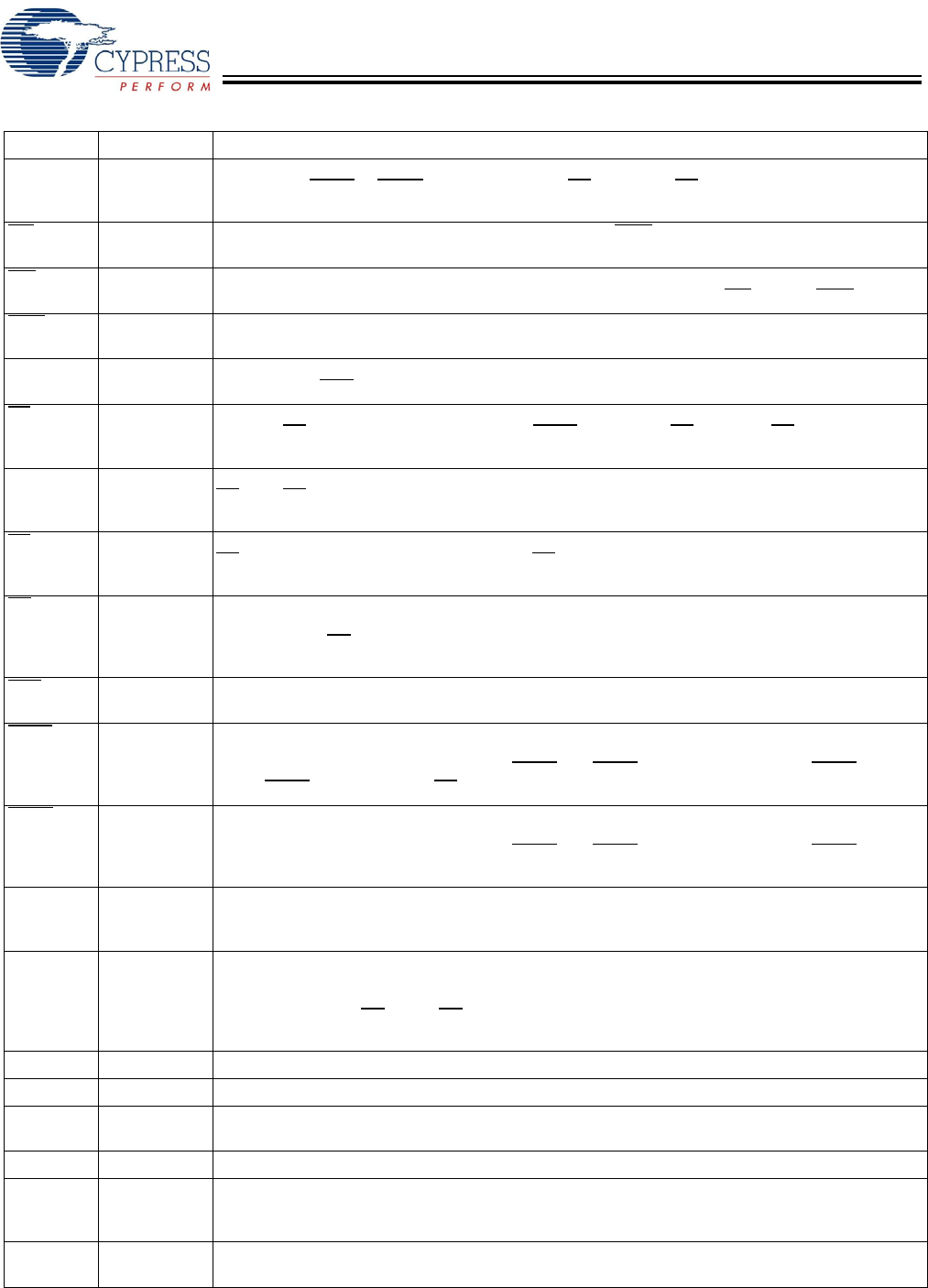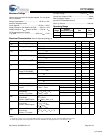
CY7C1298H
Document #: 38-05665 Rev. *B Page 4 of 16
Pin Descriptions
Pin Type Description
A0, A
1
, A Input-
Synchronous
Address Inputs used to select one of the 64K address locations. Sampled at the rising edge
of the CLK if ADSP
or ADSC is active LOW, and CE
1
,
CE
2
, and
CE
3
are sampled active. A
[1:0]
are
fed to the two-bit counter.
BW
[A:B]
Input-
Synchronous
Byte Write Select Inputs, active LOW. Qualified with BWE to conduct byte writes to the SRAM.
Sampled on the rising edge of CLK.
GW
Input-
Synchronous
Global Write Enable Input, active LOW. When asserted LOW on the rising edge of CLK, a global
write is conducted (ALL bytes are written, regardless of the values on BW
[A:B]
and BWE).
BWE
Input-
Synchronous
Byte Write Enable Input, active LOW. Sampled on the rising edge of CLK. This signal must be
asserted LOW to conduct a byte write.
CLK Input-
Clock
Clock Input. Used to capture all synchronous inputs to the device. Also used to increment the burst
counter when ADV
is asserted LOW, during a burst operation.
CE
1
Input-
Synchronous
Chip Enable 1 Input, active LOW. Sampled on the rising edge of CLK. Used in conjunction with
CE
2
and CE
3
to select/deselect the device. ADSP is ignored if CE
1
is HIGH. CE
1
is sampled only
when a new external address is loaded.
CE
2
Input-
Synchronous
Chip Enable 2 Input, active HIGH. Sampled on the rising edge of CLK. Used in conjunction with
CE
1
and CE
3
to select/deselect the device. CE
2
is sampled only when a new external address is
loaded.
CE
3
Input-
Synchronous
Chip Enable 3 Input, active LOW. Sampled on the rising edge of CLK. Used in conjunction with
CE
1
and
CE
2
to select/deselect the device. CE
3
is sampled only when a new external address is
loaded.
OE
Input-
Asynchronous
Output Enable, asynchronous input, active LOW. Controls the direction of the I/O pins. When
LOW, the I/O pins behave as outputs. When deasserted HIGH, I/O pins are tri-stated, and act as
input data pins. OE
is masked during the first clock of a read cycle when emerging from a deselected
state.
ADV
Input-
Synchronous
Advance Input signal, sampled on the rising edge of CLK, active LOW. When asserted, it
automatically increments the address in a burst cycle.
ADSP
Input-
Synchronous
Address Strobe from Processor, sampled on the rising edge of CLK, active LOW. When
asserted LOW, addresses presented to the device are captured in the address registers. A
[1:0]
are
also loaded into the burst counter. When ADSP
and ADSC are both asserted, only ADSP is recog-
nized. ASDP
is ignored when CE
1
is deasserted HIGH.
ADSC
Input-
Synchronous
Address Strobe from Controller, sampled on the rising edge of CLK, active LOW. When
asserted LOW, addresses presented to the device are captured in the address registers. A
[1:0]
are
also loaded into the burst counter. When ADSP
and ADSC are both asserted, only ADSP is recog-
nized.
ZZ Input-
Asynchronous
ZZ “sleep” Input, active HIGH. When asserted HIGH places the device in a non-time-critical
“sleep” condition with data integrity preserved. For normal operation, this pin has to be LOW or left
floating. The ZZ pin has an internal pull-down.
DQs
DQP
[A:B]
I/O-
Synchronous
Bidirectional Data I/O lines. As inputs, they feed into an on-chip data register that is triggered by
the rising edge of CLK. As outputs, they deliver the data contained in the memory location specified
by the addresses presented during the previous clock rise of the read cycle. The direction of the
pins is controlled by OE
. When OE is asserted LOW, the pins behave as outputs. When HIGH, DQs
and DQP
[A:B]
are placed in a tri-state condition.
V
DD
Power Supply Power supply inputs to the core of the device.
V
SS
Ground Ground for the core of the device.
V
DDQ
I/O Power
Supply
Power supply for the I/O circuitry.
V
SSQ
I/O Ground Ground for the I/O circuitry.
MODE Input-
Static
Selects Burst Order. When tied to GND selects linear burst sequence. When tied to V
DD
or left
floating selects interleaved burst sequence. This is a strap pin and should remain static during
device operation. Mode Pin has an internal pull-up.
NC No Connects. Not internally connected to the die. 2M, 4M, 9M, 18M, 72M, 144M, 288M, 576M and
1G are address expansion pins and are not internally connected to the die.
[+] Feedback


















